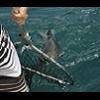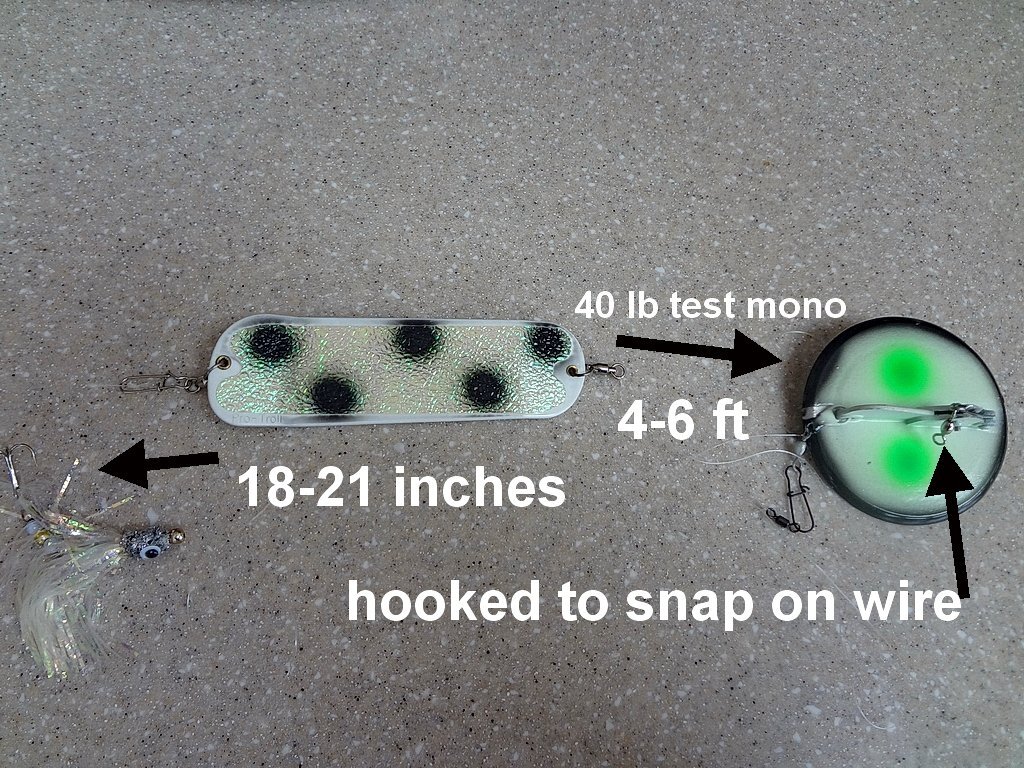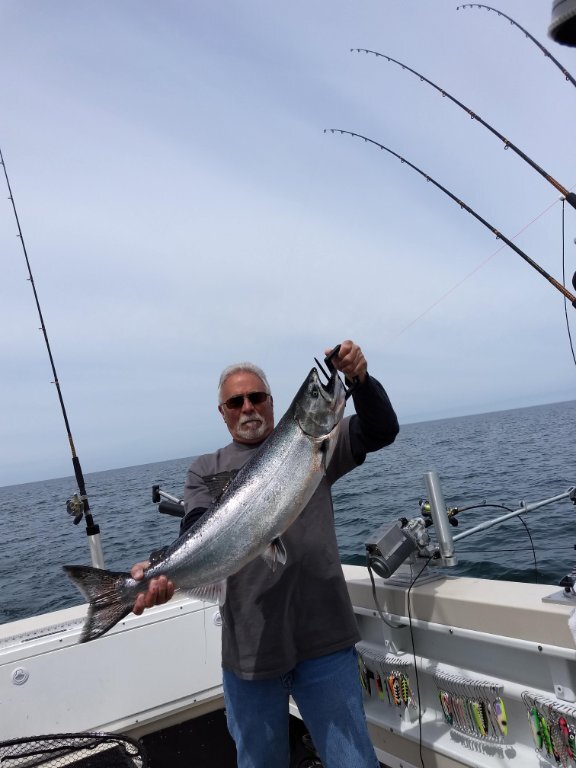-
Posts
1,545 -
Joined
-
Last visited
Everything posted by TyeeTanic
-

Careful out there: ice fishing leads to prostitution
TyeeTanic replied to LazyRiver585's topic in Ice fishing
These guys have lost it completely. OK to have drug needle tents pop up in parks ... but ice fishing ... are you out of your mind, imagine the prostitution!! LOL. -

coho salmon
TyeeTanic replied to BAYONNE59's topic in New York Fishing Reports - Lake Ontario (South Shore)
Early or late .... they like cold water ... and we normally catch them higher up the water column (top 20'). -
No one likes the gas price ... but if you buy a boat, maintain it, insurance, storage ... and all that cost ... and then worried about $50 of gas a trip ... you shouldn't own a boat.
-
Most guys put them about midway down the boat on the sides, right next to or just behind the captain's seat. This keeps them well away from the lines. You just want them in a place where you can get them in and out of the water easily, and away from the stern for sure.
-

Spoons with snaps??
TyeeTanic replied to letterman1's topic in Welcome to Lake Ontario United - Fishing Forum
There's two camps ... and I'm not sure I ever saw conclusive evidence that one way is better than the other. - the camp that supports bb snap swivels says you need the snap to optimize lure action. - the camp that supports no snap ... they say it's just more hardware the fish can see, and it is a deterrent. Personally, I go on the advice of Captain Dan Keating ... find the smallest ball bearing snap swivel you can get, and use that. For sure, you want stealth, but my opinion is, not at the expense of lure action. -
I used a troll plate in the past, you really lose your ability to steer. That's the one big downfall. I would agree with the others, drift bags are your best bet ... provides stability to the boat too ... if you have a bag out on each side.
-
-

Mono for divers/flashers
TyeeTanic replied to HoundsNTrout's topic in Questions About Trout & Salmon Trolling?
-
I would say the best setup is a 10ft rod behind (closer to bow) an 8 ft rod (closer to stern) ... but that is not necessary. I wouldn't bother changing your 9 foot rods, but if you can get 10 ft for the back, that would be good. As others say, space them at least 24" apart on the gunwale. You want the dispey off the bow rod (10') to be running higher in the water, and farther from the boat. So typically we go 3 setting on the dipsey, and use a regular ... never a mag on this rod. For the rod closer to the stern, we would set on 1, and use either a regular or a mag diver (bigger disk). The reason you want this is when a dipsey pops with a fish bite, it will always RISE and move to the CENTER of the boat. So the outside line has to be higher, so it goes over the inside line (rod closer to stern), and not tangle up the lines. If you have the choice, deploy the outside lines first (bow rods), then the inside rods (stern rod) ... reason is, as you deploy, you're not allowing the dipsey to bite in the water ... so it has a tendency to dive deeper (think of it like it's sinking in stagnant water), and it doesn't pull to the side as much. Only once you lock the bail, will you get it to bite into the water and start pulling up and to the side. So, if you deploy the outside line (bow rod) say after the inside line ... you could get tangles. Now some of us got real good at this, and have no issues getting an outside line out while the inside line is already deployed. The trick is to let that dipsey out SLOW ... so it does bite a bit into the water and moves to the side (on 3 setting).
-
-
Unfortunately with deposits, and the money at stake ... these guys have to weigh up the risks of a forced cancellation. My whole family got omicron over a week ago. This variant seems to be weak, we got a cough and a bit of nasal/head congestion ... but it wasn't that bad, we almost carried on our normal routine ... it would be at worst like an old head cold. I thought this variant was a blessing in disguise ... if it builds immunity, than this is the variant you'll want to get of the choices out there! Anyhow, I think everyone is freaking out again ... and society needs to chill a little bit, especially over Omicron.
-
Fourthly, lots of turbulent water behind a ball ... would probably screw up the downspeed measurement. Fifthly ... shipping adds a lot of cost to the product ... lead is heavy. Sixthly ... most people already have balls (that came out wrong!) ... and don't want to pay another $150 for lead ... and then you'll have arguments and need selection at 8 lb, 10 lb, 12 lb, 16 lb, 18 lb, 20 lb, 25 lb weight options ... to much of a headache. Sevently ... most balls have a ring where you can connect right at the ball ... so just clamp it to your balls if you want too (that came out wrong again).
-

Mono for divers/flashers
TyeeTanic replied to HoundsNTrout's topic in Questions About Trout & Salmon Trolling?
I misread the post I was replying to ... sorry I was reading fast, and didn't realize we had switched to braid line ... the OP spoke about using mono line ... and I'm concerned about getting down that deep with mono, even with the weight ... there's gonna be tonnes of drag. Yes, I agree if you have a MAG ring on a dipsey, or weighted ring on a diver, and using braid or wire line ... you can get to below 85'. -
I'm listening to this guy! By the way, here's my comedic take on all this ... with supply shortages on virtually everything ... I wouldn't be too excited about finding deals ... people are paying PREMIUM to get stuff. Just be happy if you can get your hands on decent product.
-

New SalmonAngler/Gear questions
TyeeTanic replied to Odie 1's topic in Questions About Trout & Salmon Trolling?
I agree with this, but a few additional thoughts. I'd want to know how they joined the wire to the mono ... I wouldn't want that wire cutting through the mono line, otherwise goodbye to everything. The CV 30D for sure holds 1000 ft of 7 strand wire ... that's what I used on all my setups. I'd still go for the CV 30D for the downriggers ... if you're putting on 30# mono (which is what I recommend, 40# I find starts getting a bit too stiff and thick) ... you'll want a 30 size reel to get a decent amount of mono on the reel. -

Mono for divers/flashers
TyeeTanic replied to HoundsNTrout's topic in Questions About Trout & Salmon Trolling?
A 12 lb weight on a rigger has about 40 ft to 50 ft of blowback, when you try and hit 100ft to 120 ft deep. (So you need 150 ft of line out to get 100 ft down). How much blowback you think a 7 oz (little more than half pound weight) weight will have? Answer ... tonnes, you'll have a tough time reaching 100 ft without the right diver on it to assist. -

Mono for divers/flashers
TyeeTanic replied to HoundsNTrout's topic in Questions About Trout & Salmon Trolling?
-
No doubt, manufacturers establish a MSRP ... and they watch it. Sure there are sales, but often this comes down from the manufacturer themselves. Cars, electronics, etc. It's not price fixing in the sense that, you are free to choose another electronic supplier and pay for something cheaper. A manufacturer may decide the sale price of their product, under contract through a retailer.
-

Mono for divers/flashers
TyeeTanic replied to HoundsNTrout's topic in Questions About Trout & Salmon Trolling?
Yeah for sure. We often have 300 ft of wire out ... with mono, you'd never get to the same depth, even if you let out all 700 ft. You'd probably snap on a heavy torpedo weight to help with the depth, and have 400 ft of line out. Then when a nice fish takes out another 200' to 250' of line ... you'll start messing your underpants knowing you can see the bottom of the spool. Now, if you want to do shallow water fishing ... sure, you can put on a heavy torpedo and have say 150' to 200' out ... say target top 30' of water ... it might work ... still, I wouldn't want less than 400' to 500' of mono line on the reel. Everyway you look at it ... much better to have braid than mono, and even better to have wire, given the sink rate and smaller diameter (which allows you to put that much line on the reel, often 1000' is the go to length of wire on a reel). -

Mono for divers/flashers
TyeeTanic replied to HoundsNTrout's topic in Questions About Trout & Salmon Trolling?
What reel are you going to put a minimum of 700 ft of mono on? Not your old wire ones ... that's for sure. I'd much rather use braid then mono. You won't get good sink rate and you will have a heck of a time popping a dipsey when you have 200 ft or more of that mono line out. Anyhow, I think people use 20 lb mono, because there isn't a real around that could hold enough 30 or 40 lb mono ... at least not one that doesn't cost a fortune. -
-
Everything has it's challenges. Solar energy in the desert works, until the panels are coated in dust. Then you have to bring water into the desert to clean the panels ... plus no way to recycle solar panels, it is a major contaminant in landfills. Nuclear for now is the way to go ... minimal waste (although highly radioactive) ... but we can solve that with a deep geological repository ... or send capsules of waste to the moon.
-
Nuclear fission was not a "possibility" in the 1800's. Nuclear fusion will be possible in the near future. Sustainable fusion for 30 seconds long has been demonstrated just this past month. The event is held suspended by magnets, so the high temperature of the core is not in direct contact with any materials.
-
I wouldn't put boat in neutral if you have wire divers, copper, leadcore or riggers out ... you're for sure gonna bottom out those lines, unless you are fishing shallow lines in VERY deep water. Plus you don't know what the underwater currents are doing and whether they'll send the wire divers into the rigger lines ... just asking for big trouble, could cost a lot of money and time to fix that mess. Not worth it. Plus, more chance the fish spits the hooks, if not well set, and you go into neutral.






